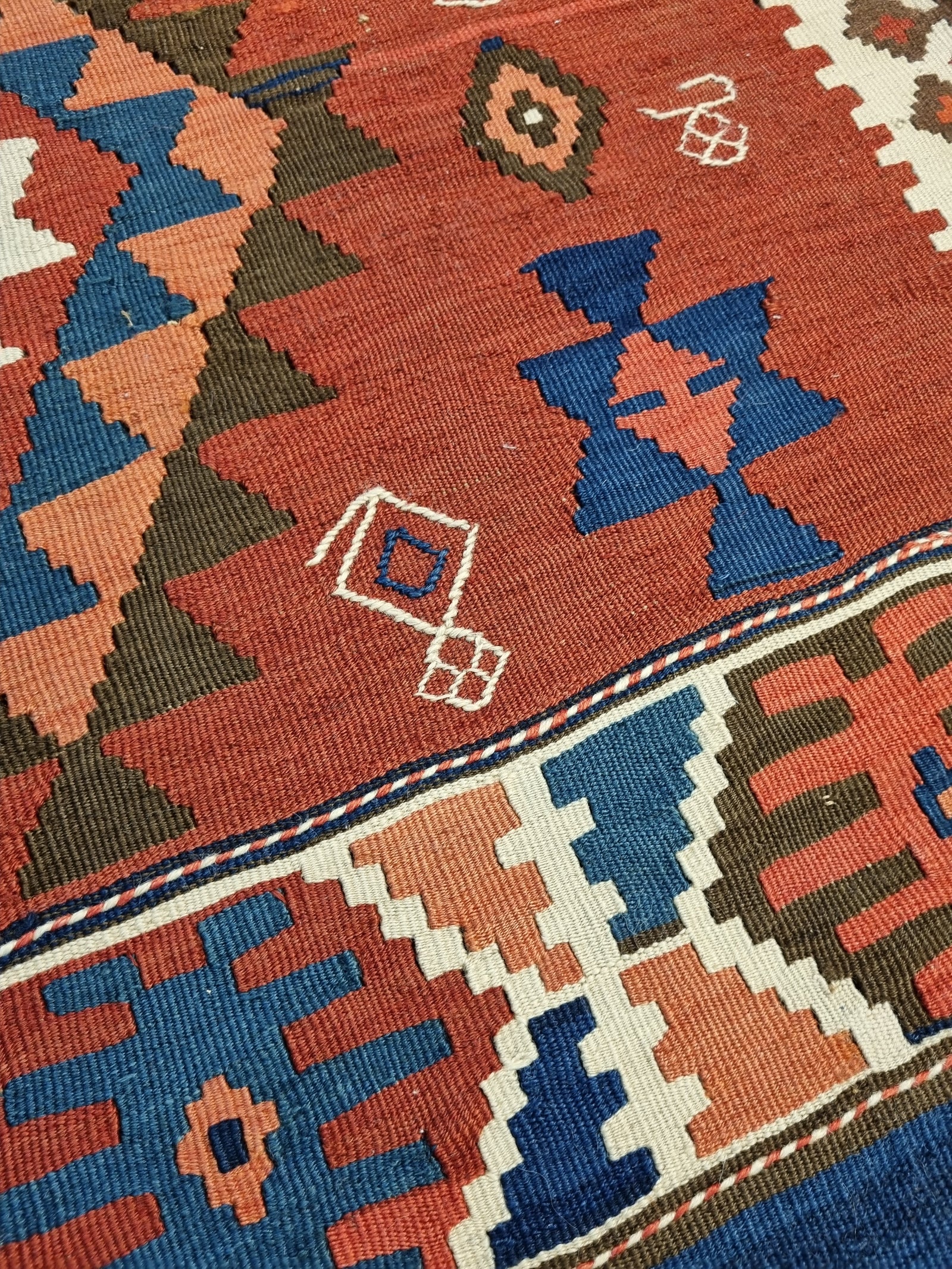Your Cart is Empty
4 min read
An Antique Caucasian Shirvan kilim.
Circa late 19th century.
Made from hand-spun wool.
Natural dyes.

The history of Azerbaijan (Atropatene in ancient texts) goes back to the Persian Satrap (governor), Atropates, who established the kingdom circa 323 BC.
He was loyal to the Persian “King of Kings” of the Achaemenid dynasty, Darius the 3rd. Atropatene was important for the Zoroastrians as it was the place for the great fire temples like Azargoshnasp. It retained its importance for nearly a thousand years from the Achaemenid empire through the Sasanids, even after the Arabs invaded Iran circa 633 AD.
Like many other regions of the ancient Iranian empire, Azerbaijan has a long history in the making of rugs. The rugs from the area are generally classified as Caucasian.
Caucasian rugs are always popular among collectors for the wealth of archetypical symbols, beautiful balance of rich colours, excellent material, and outstanding artistry.
The piece that you see here is one of such rugs. This piece is woven circa late 19th to very early 20th century. The workmanship, the wool base and amazing attention of the weaver to details indicate the age. Production in the area became largely commercial after establishing the Transcaucasian train system at the beginning of the 20th century.

It is far remote from commercial production. The aesthete weaver has passionately woven this rug with great skill. The size of this kilim and her incredible attention to detail implies that this piece was most probably woven for the ceremonial purposes of her family.

The repeated wine glass motives (above) in the coral field point to happiness and could mean feelings ranging from material joy to spiritual exuberance. The other important symbol in the design is the bird with open wings (above page 1), which points to an urge for transcendence.
Many of such motives are part of the weaver's cultural and collective memory that sometimes are woven instinctually and unconsciously as the weavers create the patterns from memory and without pre-drafted plans.
Kilims are flat-woven rugs in which the colourful threads of yarn used as weft are intertwined with warps to form the pattern. In such a technique creating curves and following patterns from a draft is a challenge. Therefore the weavers largely depend on their memory to create the designs. Some of the patterns are what they have learned from their ancestors, and they develop elements of design spontaneously from their memory.
The piece here is far remote from commercial production. The aesthete weaver has passionately woven this rug with great skill. The size of this kilim and her incredible attention to detail implies that this piece was most probably woven for the ceremonial purposes of her family.
A caucasian kilim,
Circa late 19th century.
Hand-spun wool, natural dyes.

The piece here is an extraordinary kilim for its superb quality and the earlier kilim from the Azerbaijan province. The weavers of such kilims were Armenians who used to live in the west of the region.
Although the superiority of the workmanship, texture, finishing and colours makes this kilim one of the most remarkable, the design represents a different dimension.
Many such kilims reflect archetypical symbols guarded and passed on from generation to generation.
The main design of the rug consists of a mesmerising arrangement of triangles.
The interpenetrating equilateral triangles have existed in the eastern and western cultures for thousands of years.
"The triangle is a symbol of the triune nature of the universe: Heaven, Earth, Man; father, mother, child; man as body, soul and spirit; mystical number three; three, the first flat figures. Hence the symbol of the surface in general. The surface consists of triangles" (Plato).

Plato wasn't the first to interpret the symbol. Triangle has been used in various forms in architecture and artefacts in different parts of the world; the most well-known examples are the Yantras of Buddhists and the Star of David. In most cultures opposing triangles represent two balancing elements like male and female or spirit and body that point to the archetype of the "self" and a complete form.

Like the previous one, this kilim demonstrates a stylised bird with open wings. The weavers use such motifs and symbols often because they live in an area that was a cradle of eastern mysticism.
In addition to the symbolic motifs, the weaver of this rug, probably a young girl, has incorporated her creation of motifs that makes this kilim very special.
These motifs include her depiction of herself and two male figures. The two could be either a repeat of the same person that could be the lover or two important men in the girl's life (e.g. brothers).


The other interesting element is the stylised samovar that could interpret as her love of entertaining guests at her home. Tea, prepared on the samovar, is the most common way of greeting guests at home.

There are other interesting symbols, such as the protection motifs that keep away even eyes, the Rams horn/(head) as the symbol of strength and power and the flame that stand for Azerbaijan that is known as land of fire.



Both of these pieces are made by weavers who have intertwined their feelings and emotions within the lines of these weavings and sometimes coded messages for those who could see and understand them. This makes such weavings mysterious and exciting. Their beauty goes far beyond aesthetics. They are works of beautiful minds that carry forward centuries of tradition and culture.
